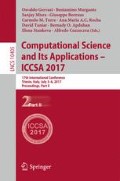Abstract
Machine learning methods are frequently used for data sets in many fields including medicine for purposes of feature extraction and pattern recognition. This study includes lesion data obtained from Magnetic Resonance images taken in three different years and belonging to 120 individuals (with 76 RRMS, 6 PPMS, 38 SPMS). Many alternative methods are used nowadays to be able to find out the strong and distinctive features of Multiple Sclerosis based on MR images. Deep learning has the working capacity pertaining to a much wider scaled space (120 \(\times \) 228), less dimension (50 \(\times \) 228) (also referred to as distinctive) feature space and SVM (120 \(\times \) 228). Deep learning has formed a more skillful system in the classification of MS subgroups by working with fewer sets of features compared to SVM algorithm. Deep learning algorithm has a better accuracy rate in comparing the MS subgroups compared to multiclass SVM algorithm kernel types which are among the conventional machine learning systems.
Access this chapter
Tax calculation will be finalised at checkout
Purchases are for personal use only
References
Duncan, I.D., Franklin, R.J.: Myelin Repair and Neuroprotection in Multiple Sclerosis, pp. 23–47. Springer Science and Business Media, Heidelberg (2012)
Murray, T.J., Saunders, C., Holland, N.J.: Multiple Sclerosis: A Guide for the Newly Diagnosed, pp. 1–39. Demos Medical Publishing, New York (2012)
Scalfari, A., Lederer, C., Daumer, M., Nicholas, R., Ebers, G.C., Muraro, P.A.: The relationship of age with the clinical phenotype in multiple sclero sis. Multiple Scler. J. 22(13), 1750–1758 (2016)
McAlpine, D., Compston, A.: McAlpine’s Multiple Sclerosis, pp. 2–10. Elsevier Health Sciences, Amsterdam (2005)
Hirst, C., Ingram, G., Swingler, R., Compston, D.A.S., Pickersgill, T., Robertson, N.P.: Change in disability in patients with multiple sclerosis: a 20-year prospective population-based analysis. J. Neurol. Neurosurg. Psychiatry 79(10), 1137–1143 (2008)
Liu, S., Liu, S., Cai, W., Pujol, S., Kikinis, R., Feng, D.: Early diagnosis of Alzheimer’s disease with deep learning. In: IEEE 11th International Symposium Biomedical Imaging (ISBI), pp. 1015–1018 (2014)
Xie, R., Quitadamo, A., Cheng, J., Shi, X.: A predictive model of gene expression using a deep learning framework. In: IEEE International Conference Bioinformatics and Biomedicine (BIBM), pp. 676–681 (2016)
Wang, A., Wang, J., Lin, H., Zhang, J., Yang, Z., Xu, K.: Biomedical event extraction based on distributed representation and deep learning. In: 2016 IEEE International Conference on Bioinformatics and Biomedicine (BIBM), p. 775 (2016)
Sarraf, S., Tofighi, G.: Deep learning-based pipeline to recognize Alzheimer’s disease using fMRI data. In: Future Technologies Conference, pp. 816–820 (2016)
Petersson, H., Gustafsson, D., Bergstrom, D.: Hyperspectral image analysis using deep learning: a review. In: 2016 6th International Conference Image Processing Theory Tools and Applications (IPTA), pp. 1–6 (2016)
Brosch, T., Yoo, Y., Li, D.K.B., Traboulsee, A., Tam, R.: Modeling the variability in brain morphology and lesion distribution in multiple sclerosis by deep learning. In: Golland, P., Hata, N., Barillot, C., Hornegger, J., Howe, R. (eds.) MICCAI 2014. LNCS, vol. 8674, pp. 462–469. Springer, Cham (2014). doi:10.1007/978-3-319-10470-6_58
Brosch, T., Tang, L.Y., Yoo, Y., Li, D.K., Traboulsee, A., Tam, R.: Deep 3D convolutional encoder networks with shortcuts for multiscale feature integration applied to multiple sclerosis lesion segmentation. IEEE Trans. Med. Imaging 35(5), 1229–1239 (2016)
Karaca, Y., Zhang, Y., Cattani, C., Ayan, U.: The differential diagnosis of Multiple Sclerosis using convex combination of infinite kernels. CNS Neurol. Disord. Drug Targets 16(1), 36–43 (2017)
Karaca, Y., Osman, O., Karabudak, R.: Linear modeling of multiple sclerosis and its subgroups. Turk. J. Neurol. 21, 7–13 (2015)
Rajan, S.S.: MRI A Conceptual Overview. Library of Congress Catalog in Publication Data. Springer, New York (1998)
Mamoshina, P., Vieira, A., Putin, E., Zhavoronkov, A.: Applications of deep learning in biomedicine. Mol. Pharm. 13(5), 1445–1454 (2016)
Deng, L., Yu, D.: Deep learning methods and applications. Found. Trends Sig. Process. 7(3–4), 230–239 (2014)
Graupe, D.: Deep Learning Neural Networks: Design and Case Studies, pp. 23–53. World Scientific Publishing, Singapore (2016)
Galas, D.J., Dewey, T.G., Kunert-Graf, J., Sakhanenko, N.A.: Expansion of the Kull back-Leibler divergence, and a new class of information metrics. Entropy Inf. Theor. MDPI 6(2), 8 (2017)
Goodfellow, I., Bengio, Y., Courville, A.: Deep Learning, pp. 155–194. MIT Press, Cambridge (2016)
Suthaharan, S.: Machine Learning Models and Algorithms for Big Data Classification: Thinking with Examples for Effective Learning, vol. 36. Springer (2015)
Han, J., Kamber, M., Pei, J.: Data Mining Concepts and Techniques, 3rd edn., pp. 408–413. Elsevier, Amsterdam (2012)
Amari, S.I., Wu, S.: Improving support vector machine classifiers by modifying kernel functions. Neural Netw. 12(6), 783–789 (1999)
Fung, G.M., Mangasarian, O.L.: Multicategory proximal support vector machine classifiers. Mach. Learn. 1–21 (2004)
Karaca, Y., Hayta, Ş., Karabudak, R.: Case study application for C-support vector classification: the estimation of MS subgroup classification with selected kernels and parameters. Eur. J. Pure Appl. Math. 9(2), 196–215 (2016)
Author information
Authors and Affiliations
Corresponding author
Editor information
Editors and Affiliations
Rights and permissions
Copyright information
© 2017 Springer International Publishing AG
About this paper
Cite this paper
Karaca, Y., Cattani, C., Moonis, M. (2017). Comparison of Deep Learning and Support Vector Machine Learning for Subgroups of Multiple Sclerosis. In: Gervasi, O., et al. Computational Science and Its Applications – ICCSA 2017. ICCSA 2017. Lecture Notes in Computer Science(), vol 10405. Springer, Cham. https://doi.org/10.1007/978-3-319-62395-5_11
Download citation
DOI: https://doi.org/10.1007/978-3-319-62395-5_11
Published:
Publisher Name: Springer, Cham
Print ISBN: 978-3-319-62394-8
Online ISBN: 978-3-319-62395-5
eBook Packages: Computer ScienceComputer Science (R0)

